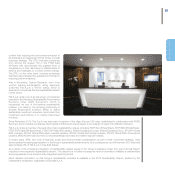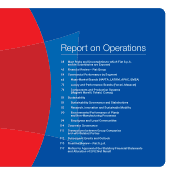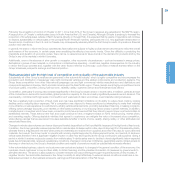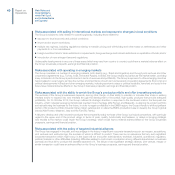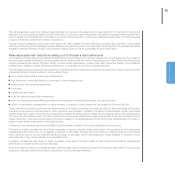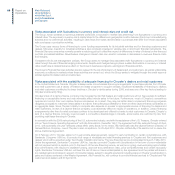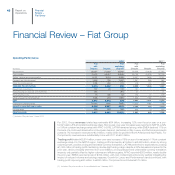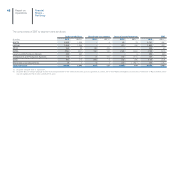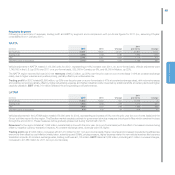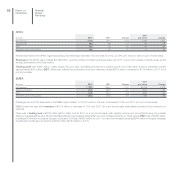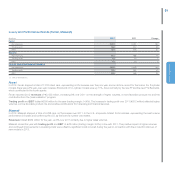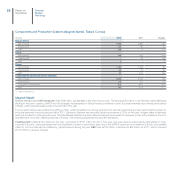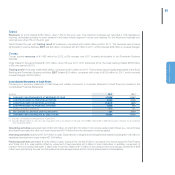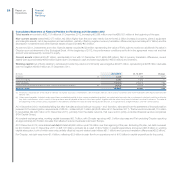Chrysler 2012 Annual Report Download - page 45
Download and view the complete annual report
Please find page 45 of the 2012 Chrysler annual report below. You can navigate through the pages in the report by either clicking on the pages listed below, or by using the keyword search tool below to find specific information within the annual report.
44
Risks associated with fluctuations in currency and interest rates and credit risk
The Group, which operates in numerous markets worldwide, is exposed to market risks stemming from fluctuations in currency and
interest rates. The exposure to currency risk is mainly linked to the difference in geographic location between the Group’s manufacturing
activities and its commercial activities, resulting in cash flows from sales denominated in currencies that differ from those associated
with purchases or production activities.
The Group uses various forms of financing to cover funding requirements for its industrial activities and for financing customers and
dealers. Moreover, liquidity for industrial activities is also principally invested in variable-rate or short-term financial instruments. The
Financial Services companies normally operate a matching policy to offset the impact of differences in rates of interest on the financed
portfolio and related liabilities. Nevertheless, changes in interest rates can result in increases or decreases in revenues, finance costs
and margins.
Consistent with its risk management policies, the Group seeks to manage risks associated with fluctuations in currency and interest
rates through the use of financial hedging instruments. Despite such hedges being in place, sudden fluctuations in currency or interest
rates could have a material adverse effect on the Group’s business prospects, earnings and financial position.
The Group’s Financial Services activities are also subject to the risk of insolvency of dealers and end customers, as well as unfavorable
economic conditions in markets where these activities are carried out, which the Group seeks to mitigate through the credit approval
policies applied to dealers and end customers.
Risks associated with the availability of adequate financing for Chrysler’s dealers and retail customers
In the United States and Canada, Chrysler’s dealers enter into wholesale financing arrangements to purchase vehicles from Chrysler
and retail customers use a variety of finance and lease programs to acquire vehicles. Insufficient availability of financing to dealers
and retail customers contributed to sharp declines in Chrysler’s vehicle sales during 2008, and was one of the key factors leading to
Chrysler’s bankruptcy filing.
Chrysler’s lack of a captive finance company may increase the risk that dealers and retail customers will not have access to sufficient
financing on acceptable terms and may adversely affect vehicle sales in the future. Furthermore, most of Chrysler’s competitors
operate and control their own captive finance companies: as a result, they may be better able to implement financing programs
designed principally to maximize vehicle sales in a manner that optimizes profitability for them and their captive finance companies on
an aggregate basis. Since Chrysler’s ability to compete also depends on access to appropriate sources of financing for dealers and
retail customers, its lack of a captive finance company could adversely affect its results of operations. In addition, unless financing
arrangements other than for retail purchase continue to be developed and offered by banks to retail customers in Canada, Chrysler’s
lack of a captive finance company could present a competitive disadvantage in Canada, since banks are restricted by law from
providing retail lease financing in Canada.
In connection with the 2009 restructuring of the U.S. automotive industry, and with the assistance of the U.S. Treasury, Chrysler entered
into an “Auto Finance Operating Agreement” with Ally Financial Inc. (hereafter “Ally”); the agreement with Ally extends through 30 April
2013, with automatic one year renewals unless either party elects not to renew. Ally historically was the captive finance company of
General Motors Company, one of Chrysler’s main competitors. On 25 April 2012, Chrysler notified Ally of its election not to renew the
above-mentioned agreement.
On 6 February 2013, Chrysler signed a 10-year private-label agreement, subject to early termination in certain circumstances, with
Santander Consumer USA Inc. to provide a full range of wholesale and retail financing services to Chrysler and Fiat customers and
dealers which will be provided under the Chrysler Capital brand name. The new financing service is scheduled to launch 1 May 2013.
Under the agreement, Santander Consumer USA Inc. has also provided Chrysler with consideration in the form of a non-refundable
upfront payment which is payable prior to the launch of the new financing service, as well as on-going revenue sharing opportunities
and commitments with respect to available funding, approval and penetration rates, price competitiveness and certain exclusivity
rights. Santander Consumer USA Inc. will bear the risk of loss on loans contemplated by the agreement and the parties will share in
any residual gains and losses in respect of consumer leases, subject to specific provisions including caps on Chrysler’s participation in
gains and losses contained in the Master Agreement. Ally Financial Inc. will continue to provide financial services to Chrysler and Fiat
customers and dealers until 30 April 2013.
Main Risks and
Uncertainties to
which Fiat S.p.A.
and its Subsidiaries
are Exposed
Report on
Operations



